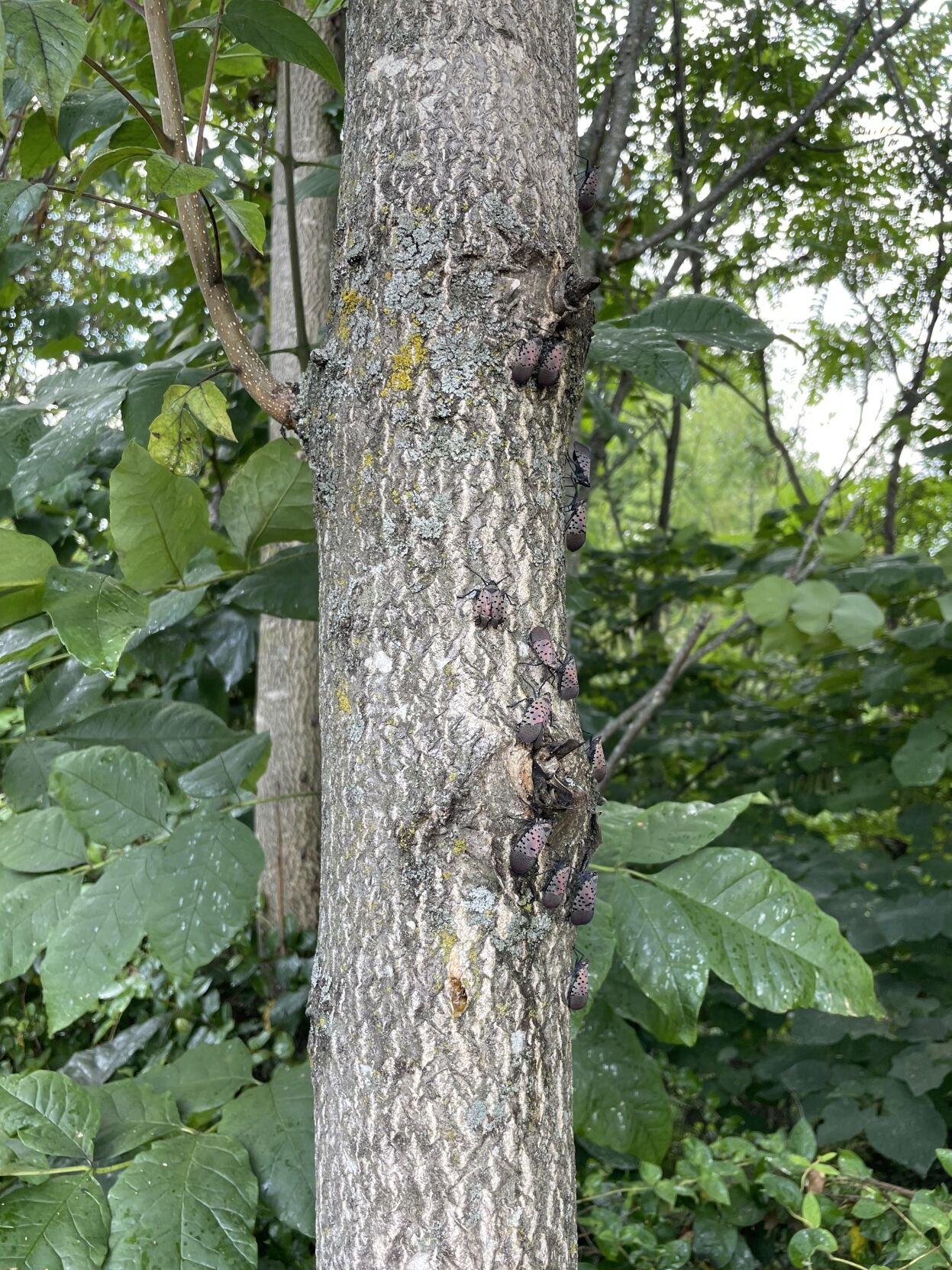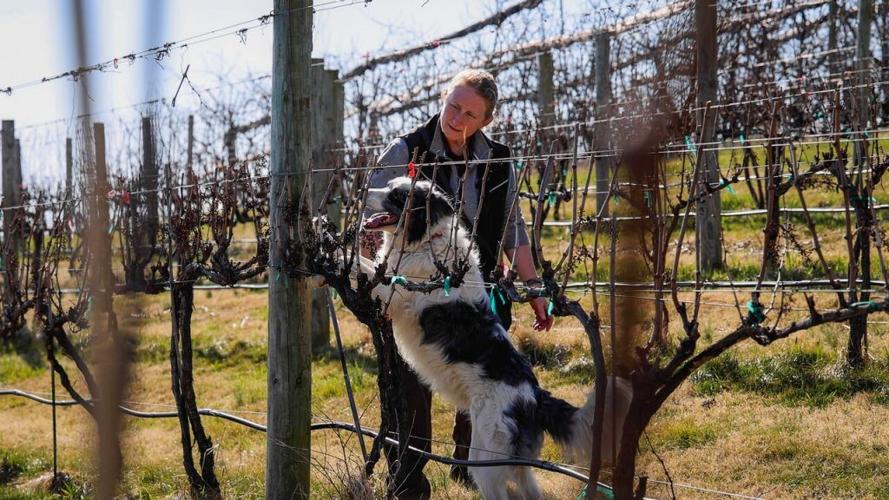The polka-dotted hitchhikers likely arrived in town by rail. Kill them on sight, officials say.
Invasive spotted lanternflies have breached ┬ķ╗©╩ėŲĄ, as the insectŌĆÖs yearslong advance south into Virginia continues. A few individual reports of spotted lanternflies first reached ┬ķ╗©╩ėŲĄ in 2022, and photos of bug bunches have circulated on social media all summer.

A spotted lanternfly nymph is seen on a shed in ┬ķ╗©╩ėŲĄ this summer. The Virginia Department of Wildlife Resources says invaders should be squashed on sight.
ŌĆ£The number one way that weŌĆÖll see spotted lanternfly spreading is along the railroad,ŌĆØ said Jules Amanita, spotted lanternfly field supervisor for the Virginia Department of Agriculture and Consumer Services.
ŌĆ£It was a railyard where spotted lanternfly was originally found in ┬ķ╗©╩ėŲĄ and Salem, next to the greenway,ŌĆØ she said. TheyŌĆÖve also been found all along the Interstate 81 corridor, including in Montgomery and Pulaski counties, and Radford.
People are also reading…

A spotted lanternfly nymph is seen on a shed in ┬ķ╗©╩ėŲĄ this summer. The Virginia Department of Wildlife Resources warns the insect is an invasive pest that damages grapevines, fruit trees and maples, and should be squashed on sight.
Virginia is one of 19 states where the spotted lanternfly has spread, she said. ThatŌĆÖs a fast rate for a bug to travel since about 2012, when it was mistakenly imported from southeast Asia to a port in Pennsylvania.
ŌĆ£It is the fastest-moving invasive insect in the United States currently, and quite probably ever,ŌĆØ Amanita said. ŌĆ£It will lay its egg masses on peopleŌĆÖs cars, on trucks, on trains, on stuff thatŌĆÖs stored outside, as well as on plant material.ŌĆØ
The sap-sucking buggers cause crop damage, and produce a nasty byproduct for lawncare. Researchers at Virginia Tech used loyal dogs and soldierly ants to devise new methods of detecting the pestilent spotted lanternfly, and other invasive species like it.
Dogs can use their superior sense of smell to track wild game, drugs and people, but what about bug eggs? After 25 years as a search and rescue dog handler, these were the questions bothering Sally Dickinson.

Sally Dickinson and her detection dog, Flint, sniff for spotted lanternfly eggs at a vineyard at the Virginia Tech research and extension center in Winchester.
ŌĆ£I came up with a lot of questions that I wanted to answer,ŌĆØ Dickinson said. ŌĆ£So I decided to make the jump and go back to school.ŌĆØ
As a doctoral candidate in applied animal behavior and welfare at Virginia Tech, she took up a science project that built on research findings from Texas Tech.
ŌĆ£We already knew dogs could detect spotted lanternfly from a lab perspective,ŌĆØ Dickinson said. ŌĆ£We asked the question: can citizen scientists who have some experience doing scent work train their dogs on this new odor, and can they do it to a really high proficiency?ŌĆØ
Indeed, her team found that dogs are happy to seek out the smell of spotted lanternfly eggs. From there, itŌĆÖs a lot easier to kill the unmoving egg masses before theyŌĆÖve entered the agile nymph and adult stages.
ŌĆ£Humans are the biggest hurdle in this whole process. WeŌĆÖre so quick to blame our dog, like oh, Fido is just obstinate, or cantankerous, or whatever,ŌĆØ Dickinson said. ŌĆ£But watching an awful lot of dogs work over the years, this study really cemented to me that dogs got it. WeŌĆÖre their biggest problem.ŌĆØ
In the case of the spotted lanternfly, doggy detection work could help save crops like grapes in Virginia vineyards. The lanternflyŌĆÖs appetite for agricultural crops in Pennsylvania was estimated to cause at least $50 million of economic damage by 2020, with the number expected to climb, according to a Penn State study.
ŌĆ£If we give them some guiderails to operate, then they can certainly be an amazing force multiplier for local, grassroots conservation work,ŌĆØ Dickinson said. ŌĆ£Especially in the face of an invasive species, when weŌĆÖre looking at early detection and trying to eliminate that species.ŌĆØ
Ants never disappoint you, Scotty Yang said. An assistant professor at Virginia Tech, his team studies insect microbial interactions at the Yang Lab, specializing in ants.

Yang
ŌĆ£Ants have all kinds of cool behavior,ŌĆØ Yang said. ŌĆ£I study behavior, I study ecology. I also study their genetics. ItŌĆÖs a little bit of everything.ŌĆØ
To detect spotted lanternfly populations before theyŌĆÖve reached a visible level, YangŌĆÖs team used ants as forensic investigators. The researchers merely relied on antsŌĆÖ taste for sweets.
ŌĆ£Spotted lanternfly is a honeydew-producing insect. They feed on tree sap packed with carbohydrates, sugar, pretty much,ŌĆØ Yang said. ŌĆ£When they excrete their waste, it contains a high level of sugar. Ants like sugar.ŌĆØ
Ants seek out and consume the sweet honeydew, storing it in their stomachs to share with the colony. The honeydew also contains easily detectable amounts of spotted lanternfly DNA, he said.
ŌĆ£All we have to do is just go out there, collecting and processing ants for a signal of lanternfly DNA,ŌĆØ Yang said. ŌĆ£We will be able to know if spotted lanternflies are there or not.ŌĆØ
The test has implications for detecting invasive insect populations early, then implementing control strategies while the numbers are still manageable. ItŌĆÖs also faster to find ants than sending a team of workers to go look up trees for signs of lanternflies, he said.
ŌĆ£For us, our long-term goal is actually to use ants as an agricultural biosecurity tool,ŌĆØ Yang said. ŌĆ£We are likely to get a lot more honeydew-producing pests from overseas.ŌĆØ
Early detection is essential when it comes to curbing laternfly populations, said Amanita, the VDACS specialist. Invasive species are a problem that humans have dealt with since rats spread worldwide aided by sailing ships, she said.
ŌĆ£Invasive species tend to be the ones that really prefer our human-made environments,ŌĆØ Amanita said. ŌĆ£We are the ones who are responsible for preventing them, since weŌĆÖre the ones who are causing their spread.ŌĆØ
Now that spotted lanternflies are here, theyŌĆÖre probably not going away, and they might even get worse for a little while, she said. Just like the brown marmorated stink bug, theyŌĆÖre called pests for a reason.
ŌĆ£By the time it reaches the level of population that it has in ┬ķ╗©╩ėŲĄ now, we can control it, but eradication is way off the table,ŌĆØ Amanita said. But, ŌĆ£we may actually be able to stop it in the places where it hasnŌĆÖt yet established.ŌĆØ

A map of Virginia shows areas where spotted lanternfly has been seen as of May 2025. The pest has spread quickly across the state.┬Ā
When they made it to ┬ķ╗©╩ėŲĄ, the lanternflies found an abundance of their preferred host plant: tree of heaven, another invasive species. The tree is a common sight on roadsides, like Riverland Road Southeast, and in alleyways, introduced to North America centuries ago.
ŌĆ£Spotted lanternfly and tree of heaven co-evolved together in Asia, so they are quite heavily linked,ŌĆØ Amanita said. ŌĆ£Chances are, spotted lanternfly would not do nearly so well in North America if it werenŌĆÖt for the fact that tree of heaven is all over the place.ŌĆØ
Other localities might fare better, depending on how soon people detect the pestŌĆÖs presence, and using methods like injecting pesticides directly into the tree of heavenŌĆÖs sap.
ŌĆ£WeŌĆÖll see them start to lay eggs in September,ŌĆØ Amanita said. ŌĆ£Finding and destroying egg masses can make a really big difference, because thereŌĆÖs 30 to 50 eggs per egg mass. Even crushing just a few makes a significant impact in the population next year.ŌĆØ

Art depicts an adult spotted lanternfly. The invasive species is spreading across Virginia, and the eastern United States.
For people fighting the lanternfly in their backyards, there are organic, chemical, and manual control methods, but donŌĆÖt use home remedies like soap or bleach outside, she said. When it comes to spotted lanternflies, everyone has a license to kill.
ŌĆ£Crush them. Just crush individual insects. Go after them, kill them,ŌĆØ Amanita said. ŌĆ£Take out all of your frustrations about the world on these bugs.ŌĆØ




















